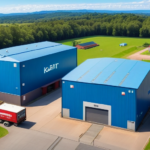Smurfit Kappa vs. Packaging Corporation of America (PCA): An SEO-Optimized Comparative Analysis
In the fiercely competitive world of packaging, two companies have emerged as industry giants – Smurfit Kappa and Packaging Corporation of America (PCA). These firms have been battling it out for years, and the question on everyone's mind is: who will come out on top in the end? To answer this, we delve into their backgrounds, financial performance, market share, sustainability practices, innovation strategies, and corporate social responsibility efforts. Let's explore each of these elements in detail.
The Background of Smurfit Kappa and Packaging Corporation of America (PCA)
Smurfit Kappa
Smurfit Kappa was founded in Ireland over 80 years ago and has since grown into a global leader in paper-based packaging. Operating in over 30 countries, it employs more than 46,000 people and produces over 12 million tonnes of paper and packaging annually. Smurfit Kappa prides itself on innovative packaging solutions catering to various industries such as food and beverage, consumer goods, and e-commerce.
Packaging Corporation of America (PCA)
Packaging Corporation of America (PCA) is an American-based firm with roots that date back over a century. Today, it stands as the fourth-largest paper and packaging company in the United States, producing over three million tonnes of containerboard annually. PCA focuses primarily on producing kraft and recycled containerboard, corrugated products, and specialty packaging solutions, operating in over 20 states in the US.
Key Differences Between Smurfit Kappa and PCA
The primary difference between Smurfit Kappa and PCA lies in their respective product offerings. While Smurfit Kappa has a diversified portfolio, producing a wide range of paper-based packaging products, PCA primarily focuses on containerboard and corrugated products.
Another significant difference is their geographical footprint. Smurfit Kappa operates globally in over 30 countries, whereas PCA is predominantly focused on the US market with a presence in a few other countries.
Additionally, Smurfit Kappa emphasizes sustainability more heavily, implementing a circular economy model aimed at using 100% of their packaging materials from sustainable sources and recycling 90% of their waste. PCA also has sustainability initiatives but they are not as extensive as those of Smurfit Kappa.
Comparative Analysis of Financial Performance
When evaluating financial performance, both Smurfit Kappa and PCA have showcased impressive results over the years, though there are noticeable differences:
- Revenue: Smurfit Kappa reported revenue of €8.5 billion in 2020, while PCA reported $6.61 billion in the same year.
- Net Income: Smurfit Kappa had a net income of €449 million compared to PCA's $749 million.
- Growth Rates: Smurfit Kappa's revenue has grown at an average annual rate of 3.3% over the past five years, whereas PCA's revenue has grown at 7.4% annually.
- Debt Levels: Smurfit Kappa has a debt-to-equity ratio of 1.06, indicating more debt than equity. In contrast, PCA has a ratio of 0.57, suggesting a stronger equity position.
Both companies operate in a growing packaging industry, driven by the rise of e-commerce. However, Smurfit Kappa's diversified product portfolio and focus on sustainable solutions may provide a long-term advantage as consumers become more environmentally conscious.
Market Share in the Packaging Industry
The packaging industry is highly competitive, with the global paper packaging market valued at approximately $300 billion in 2021 according to IBIS World. Together, Smurfit Kappa and PCA hold a combined market share of just over 5%.
- Smurfit Kappa: Holds approximately a 20% market share in Europe, with smaller shares in the Americas, Asia, and Africa.
- PCA: Dominates the US market with an estimated 40% market share.
Sustainability Practices
Sustainability is a critical focus for both companies, reflecting the increasing demand for eco-friendly practices:
- Smurfit Kappa:
- Aims for 90% recycled or chain of custody certified paper and packaging by 2025.
- Targets a 30% reduction in CO2 emissions by 2030.
- Over 70% of its energy comes from renewable sources.
- PCA:
- Plans to reduce greenhouse gas emissions by 30% by 2030.
- Increasing the use of renewable energy sources.
- Recycles over 1.5 million tonnes of paper and packaging materials annually through its recycling program.
Innovation Strategies
Innovation is essential in the packaging industry, and both companies invest heavily in developing new solutions:
- Smurfit Kappa:
- Focuses on sustainable, value-added packaging products.
- Operates research and development centers globally.
- Developed the PaperWise product line, featuring packaging made from agricultural waste.
- PCA:
- Develops new ways to utilize core products like containerboard and corrugated products.
- Invests in alternative packaging materials.
- Introduced a range of products made from recycled content.
Corporate Social Responsibility Efforts
Corporate social responsibility (CSR) is a vital consideration for consumers and investors alike:
- Smurfit Kappa:
- Promotes diversity and inclusion.
- Ensures responsible sourcing of materials.
- Supports communities through partnerships with organizations and charities in areas such as health, education, and the environment.
- PCA:
- Focuses on workplace safety.
- Responsible use of natural resources.
- Supports community initiatives and offers employee-focused programs, including training, development, and diversity initiatives.
Recent News and Developments
The rivalry between Smurfit Kappa and PCA continues with strategic moves to gain competitive advantage:
- 2020: Smurfit Kappa acquired Fabrika Hartije Beograd, a leading paper-based packaging company in Serbia, enhancing its presence in Central and Eastern Europe.
- 2021: PCA announced the acquisition of Ohio Corrugating, a US-based corrugated packaging firm, to expand its operations in the Midwest region.
- 2023: Smurfit Kappa launched a new line of biodegradable packaging solutions, reinforcing its commitment to sustainability.
- 2023: PCA invested in advanced recycling technologies to improve the efficiency of their recycling programs.
Expert Opinions on Future Leaders
Experts have varying opinions on which company will emerge victorious in the Smurfit Kappa vs. PCA rivalry:
Many analysts believe that PCA's dominance in the US market gives it a significant advantage over Smurfit Kappa. However, others argue that Smurfit Kappa's broader portfolio and international footprint could help it better weather economic downturns and capitalize on global opportunities.
Future Outlook for the Packaging Industry
The packaging industry is undergoing significant changes driven by factors such as increasing consumer demand for sustainable packaging, technological advancements, and evolving regulations. Both Smurfit Kappa and PCA will need to adapt to these changes to remain competitive.
According to Technavio, the global paper packaging market is expected to grow at a CAGR of around 4% from 2021 to 2025, driven by the demand for sustainable and eco-friendly packaging solutions.
History of Mergers and Acquisitions
Both Smurfit Kappa and PCA have a history of mergers and acquisitions to expand their operations and gain a competitive edge:
- Smurfit Kappa:
- Acquired Garcia Ballester, a Spanish paper and packaging company, in 2019.
- Purchased Reparenco, a Dutch packaging business, in 2018.
- PCA:
- Acquired TimBar Packaging and Display in 2017.
- Purchased Sacramento Container Corporation in 2016.
Investor Perspectives
The stock prices of both Smurfit Kappa and PCA have performed well in recent years, reflecting strong investor confidence:
- Smurfit Kappa: In 2020, the stock price increased by over 20%.
- PCA: The stock price rose by over 12% in 2020.
Value for Money: Smurfit Kappa vs. PCA
When comparing the value for money offered by Smurfit Kappa and PCA, several factors come into play:
- Profit Margin: PCA has a slightly higher profit margin.
- Revenue: Smurfit Kappa's higher revenue could indicate greater potential for future growth.
Ultimately, the choice between Smurfit Kappa and PCA will depend on individual investment goals and priorities.
Conclusion: Who Wins in the Battle Between Smurfit Kappa and PCA?
At this stage, it is difficult to predict a clear winner in the battle between Smurfit Kappa and PCA. Both companies have their respective strengths and weaknesses, and only time will tell which will come out on top. What is clear is that the packaging industry will continue to evolve, and companies will need to adapt to stay ahead of the curve.






















